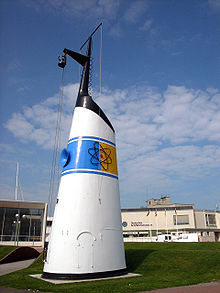- Otto Hahn (ship)
-
Otto Hahn was one of only four nuclear-powered cargo vessels so far built. Planning of a German-built trade and research vessel to test the feasibility of nuclear power in civil service began in 1960, and Otto Hahn's keel was laid down in 1963 by Howaldtswerke Deutsche Werft AG of Kiel. She was launched in 1964 and named in honour of Otto Hahn, the German chemist and Nobel prizewinner, who was credited with the discovery of nuclear fission of uranium in 1938. The first captain of the Otto Hahn was Heinrich Lehmann-Willenbrock, a famous German U-Boat ace of World War II.
In 1968, the ship's 38-megawatt nuclear reactor was taken critical and sea trials began. In October of that year, NS Otto Hahn was certified for commercial freight transport and research.
Configured to carry passengers and ore, Otto Hahn made her first port call in Safi, Morocco, loading a cargo of phosphate ores, in 1970. In 1972, after four years of operation, her reactor was refueled. She had covered some 250,000 nautical miles (463,000 km) on 22 kilograms of uranium.[1]
In 1979 Otto Hahn was deactivated. Her nuclear reactor and propulsion plant were removed and replaced by a conventional diesel engineroom. In nine years, she had traveled 650,000 nautical miles (1,200,000 km) on nuclear power, visiting 33 ports in 22 countries.
In 1983, Otto Hahn was recommissioned as the container ship Trophy and leased into commercial service. On 19 November of that year, she was renamed Norasia Susan. She became the Norasia Helga in 1985, Hua Kang He in 1989, Anais in 1998, Tal in 1999 and finally Madre in the same year. Her last owner, from 2006, was the Liberian-based Domine Maritime Corporation, under the management of Alon Maritime Corporation of Athens, Greece. The ship was scrapped at Alang, India in 2009.
Her funnel is preserved at the Deutsches Schiffahrtsmuseum (German Maritime Museum) in Bremerhaven.
Contents
General characteristics
- Displacement 25,790 tons (26,200 t) full, 16,871 tons (17,141 t) standard
- Length: 164.3 m waterline, 172.0 m overall
- Beam: 23.4 m
- Freeboard: 5.3 m
- Capacity: 14,040 gross register tons (GRT) (39,760 m³)
- Propulsion: Nuclear drive
- Speed: 15.75 knots (29 km/h)
- Waterproof compartments: 14
- Loading spaces: 6
- Complement 63 crew, 35 research personnel maximum
- Reactor
- Power: 38 MW
- Volume: 35 m³
- Pressure: 85 kp/cm² (8.3 MPa)
- Temperature: 300 °C
- Fuel: 1.7 metric tons of 3.5-6.6% enriched uranium
- Endurance under full load: 900 days
- Average fuel burn-up: 23,000 MW·d/t
- Average thermal neutron flux: 1.1×1013/(cm²·s)
- Number of elements/fuel rods: 12/2810
- Equivalent minor diameter: 1050 mm
- Active core height: 830 mm
- Fuel rod diameter: 11.4 mm
- Fuel cladding: 0.8 mm of Zircaloy-4
- Manufacturer: Deutsche Babcock & Wilcox-Dampfkesselwerke AG und Internationale Atomreaktorbau GmbH
See also
Further reading
- Hajo Neumann: Vom Forschungsreaktor zum 'Atomschiff' OTTO HAHN: Die Entwicklung von Kernenergieantrieben für die Handelsmarine in Deutschland. Hauschild Verlag, Bremen 2009, ISBN 978-3-89757-446-5 (German)
References
External links
Categories:- Cold War merchant ships of Germany
- Ships built in Kiel
- Nuclear-powered merchant ships
- 1964 ships
Wikimedia Foundation. 2010.


